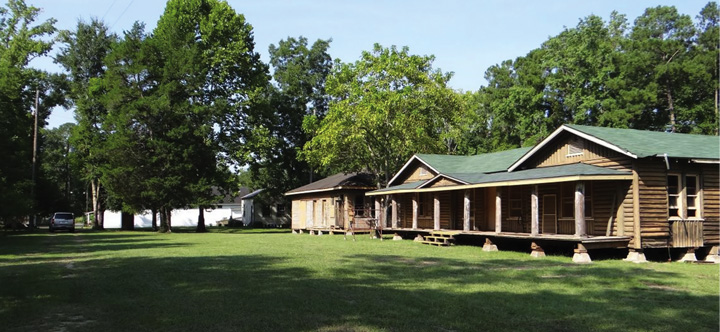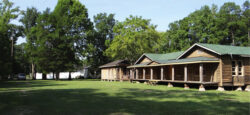Summer 2015
Corps Craftsmanship
The Alexander State Forest Headquarters building is an important structure associated with the Civilian Conservation Corps (CCC), and a particularly fine example of the Corps’ accomplishments
Published: June 16, 2015
Last Updated: January 11, 2019

Courtesy of Southern Forest Heritage Museum; photos by Everett Lueck.
The Alexander State Forest Headquarters Building was relocated from Woodworth to the grounds of the Southern Forest Heritage Museum at Long Leaf. The building will eventually house a museum dedicated to the Civilian Conservation Corps.
The CCC was one of the federal programs established to alleviate the effects of the Great Depression, when one-third of the American workforce was unemployed. Other “New Deal” initiatives included the Public Works Administration (PWA) and Works Progress Administration (WPA). The Corps would not only address the problem of unemployment, but also the country’s dwindling timber supply while reflecting the president’s personal interest in conservation. Nationwide, the logging industry had clear-cut forests at a faster pace than reforestation. Though some lumber executives had initiated reforestation in Louisiana, such as Henry Hardtner, president of the Urania Lumber Company, Roosevelt believed that a focused and massive initiative was essential.
The CCC program took off quickly and efficiently. In Louisiana, 650 applicants, of whom 100 were African American, were selected within a month. In the country as a whole, the Corps placed approximately 275,000 enrollees in camps by June 1933. While the majority of Corps members were men aged between 18 and 25, a small number, such as those at the Woodworth camp, were World War I veterans. Most CCC men were from rural areas and from what the CCC’s second director, James McEntee, described as from “economically insecure homes,” by which he meant those who never had the opportunity to hold a job or receive much in the way of education.
The CCC camp at Woodworth was settled in July 1933 and occupied by approximately 90 men of Company 2429. In the 1920s, the Louisiana Division of Forestry initiated demonstrations here of timber management and the camp’s charge was to continue and develop this effort on the almost 8,000 acres of second-growth timber and cutover land.
At first, Corps enrollees were accommodated in tents, but wooden barracks were soon constructed, along with a mess hall, officers’ quarters, an education building, latrines, a bathhouse and an administration building (now Leche Lodge). Because the Woodworth camp housed World War I veterans, it also had an American Legion post. Former members of the military usually were in charge of a camp, and some camps also employed architects, landscape architects or engineers to supervise construction.
The CCC worked closely with the National Park Service (NPS) in the design of its buildings. It adopted NPS recommendations that buildings fit harmoniously in their sites, be constructed of local materials and convey a rustic or primitive character. In areas of the country where stone was the predominant building material, so were CCC structures. In Louisiana, the buildings were of wood or brick.
Leche Lodge housed administrative offices for the Woodworth camp. It is a one-story log structure, with a front porch supported on eight plain, wooden columns. The walls are composed of half-round logs cut in a range of lengths and thicknesses, laid in horizontal and vertical patterns, and in the porch gable the logs are placed in a sunburst design. All the logs are stripped of their bark. Although retaining the bark would have given the building a more rustic and picturesque quality for its wooded location, Albert H. Good in his 1938 book, Park and Recreation Structures, warned against it. Good, who was an architectural consultant to the NPS, pointed out that logs would soon become unsightly as the bark deteriorated and fell. Moreover, logs covered with bark were more subject to rot.
He also advised that buildings should be subordinate to their setting, be small in scale, emphasize the horizontal in their massing, have simple entrances, and, unlike a building on a city street, which is primarily seen from the front, be attractive when viewed from all sides. Leche Lodge fits these recommendations admirably. Good’s book, which became the “bible” of park structures, is illustrated with plans and photographs, and is a fascinating compendium.
In the CCC’s nine years of existence, Louisiana hosted approximately 80 camps, with usually 26 in operation at any one time. The Corps launched one of its first camps in the Kisatchie forest and the enrollees were instrumental in forming the Stuart tree nursery at Pollock. Here, members collected pine cone seeds and, within a six month period, planted 48 million seedlings of longleaf and slash pine to start new trees. Roosevelt designated the area as Kisatchie National Forest in 1936.
At Chemin-a-Haut State Park near Bastrop, CCC enrollees planted trees on cutover land and built roads, a lodge, cabins and picnic shelters. Construction of recreation facilities in state parks was another of the CCC’s achievements. A company of 75 men was established in Longfellow-Evangeline State Park in October 1933. They developed a water system, bridges, roads, trails and picnic shelters. At Tchefuncte State Park and Conservation Reservation (now known as Fontainebleau State Park), 215 young men dredged and deepened an existing lagoon for small boats and fishing and constructed walkways, a brick ranger’s dwelling, a bathhouse, entrance gates and vacation cottages. Landscape architect William Wells, who devised a master plan for the park, wrote in his report of 1939, “All of the buildings are being kept in the early Louisiana style of architecture.”
The CCC’s activities ended in 1942 and the program terminated in 1943 as World War II accelerated. The program’s accomplishments were impressive. It gave employment and training in forestry, carpentry, plumbing, auto-mechanics, electricity, surveying and other skills to a total of three million men. More than that, the CCC carries a lasting legacy. Corps members planted over two billion trees across the nation and developed 800 new state parks. As Neil M. Maher relates in his book, Nature’s New Deal (2008), the CCC’s work also expanded the meaning of conservation: the need for ecological balance and an increased interest in wilderness preservation and environmentalism. In Louisiana the Corps’ successes has meant renewed forests, erosion control, roads and hiking trails, drainage systems, and levee roads, as well as picnic grounds, shelters and facilities for swimming, boating and fishing for all to enjoy.
—–
Karen Kingsley, Ph.D., is professor emerita of architecture at Tulane University, author of Buildings of Louisiana (Oxford University Press, 2003), and editor-in-chief of the Buildings of the United States series.
